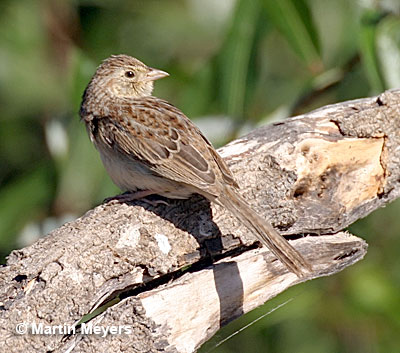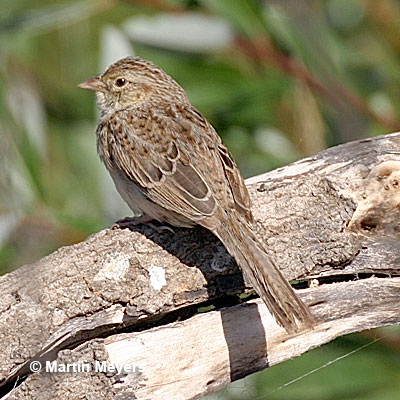Cassin's Sparrow (Aimophila
cassinii)
Stinson Beach, Marin County, California
17 September 2004
Joseph Morlan
Photos © 17 September 2004 by Martin Meyers and David Nelson. All rights
reserved. 
This morning Robbie Fischer and I drove up to Stinson Beach State Park. We hoped to see the Cassin's
Sparrow found yesterday by Dan Cooper in a grassy area directly east of the entrance kiosk. It was seen later in
the day by numerous observers including Robbie Fischer. Adam Winer kindly left a message on the Northern California
Birdbox that this cooperative sparrow was still present early today. We arrived around 11am where we met Martin
Meyers, Mike Rogers, and Ted & Christine Koundakjian. They said that the bird was still in its favorite patch
of grass. We parked and visited the site but the bird was not immediately evident. Eventually the bird flushed
a short distance, but it disappeared under vegetation in the ravine behind the grass. Then the bird flushed again
towards the south and perched on a dead snag for about 30 seconds before descending back into the grasses and weeds.
The bird skulked low in the grass, working its way slowly north where we eventually got excellent views at very
close range. The bird came within 10 feet of me on several occasions. The weather was sunny, the light excellent
and the winds light. Martin Meyers took photographs while we watched the bird, but the two that illustrate this
page were taken before we arrived. The photo by David Nelson was taken later in the day after we left.
Description
We spent about an hour studying the bird. Viewing was through 8x40 binoculars. I brought a scope, but the bird
was too skulking for it to be much use. The following is based on notes made while viewing the bird:
A large lanky sparrow with a long tail, pink legs and bill, and lacking obvious wing-bars. The crown was gray
with heavy brown streaks divided on the forehead by a short pale stripe. The dark eye was surrounded by an indistinct
grayish eyering. The lores were yellowish-buff (appearing yellow in some lighting), blending with the gray supercilium
behind the eye. The ear-coverts were gray with brown streaking, an indistinct brown border above and a small separated
brown spot to the rear. Under most lighting conditions the auriculars appeared washed with buff extending to the
malar region.
The bill was pink with a dark culmen. It appeared relatively large, long, slightly swollen, and had a slight
hook at the tip. The tomium was deeply notched near the tip and showed a slight angle or tooth near the base recalling
a tanager.
The back was gray with the mantle and scapular feathers showing rich brown centers and black bars near the tip.
The rump was brown with irregular dusky barring evident on the lower rump.
The greater coverts and tertials were gray with dusky subterminal bands and light grayish-buff fringes. There
was no visible primary projection although some longer brown secondaries extended beyond the visible tertials.
I believe that several tertials had been molted exposing the tips of older secondary feathers. One wing-covert
on the right side was loose and appeared ready to fall out (see photo).
The long tail was heavily worn at the tip with faint cross-bars visible on the central rectrices. Although these
looked like fault-bars caused by irregular growth-rates, I believe they are actually normal coloration on this
species and not true fault-bars. Short, fresh-looking uppertail covert feathers were evident, contrasting with
older, worn rectrices which did not show any white corners or tips.
The underparts were gray with a slight buff wash, most evident on the undertail coverts and flanks. The breast
was marked by very faint, thin hair-line streaks, particularly on the sides of the breast. Several broader brown
streaks were visible on the flanks.
Discussion
This is the second Cassin's Sparrow I have seen in California. The first was a singing male at the south end
of Mono Lake in June 1984. The only other mainland record for Northern California was at the mouth of the Little
River in Humboldt County 29 May 1984. However there are over a dozen records from Southeast Farallon Island suggesting
that the species should occur more often on the mainland. Perhaps its skulking behavior combined with its nondescript
appearance make it particularly difficult to detect during the fall.
Adults molt before they migrate, but this species has a presupplemental molt in its first year, which takes
place partly on the wintering grounds (Pyle, Identification Guide to North American Birds, Part I, 1997).
Thus it is likely that this is a hatching-year bird. It will be interesting to see if this bird attempts to winter
at this site or if this molt is taking place during a migratory stop-over.
This individual was a fairly richly colored with the rich brown coloration of the upperparts often showing a
bright chestnut cast. Apparently this species is somewhat polymorphic with bright and pale color morphs (P. Pyle
pers. comm.).
The barring on the rump and tail along with the flank streaking eliminate both Botteri's Sparrow (A. botterii)
and Bachman's Sparrow (A. aestivalis), neither of which have been recorded in California.


